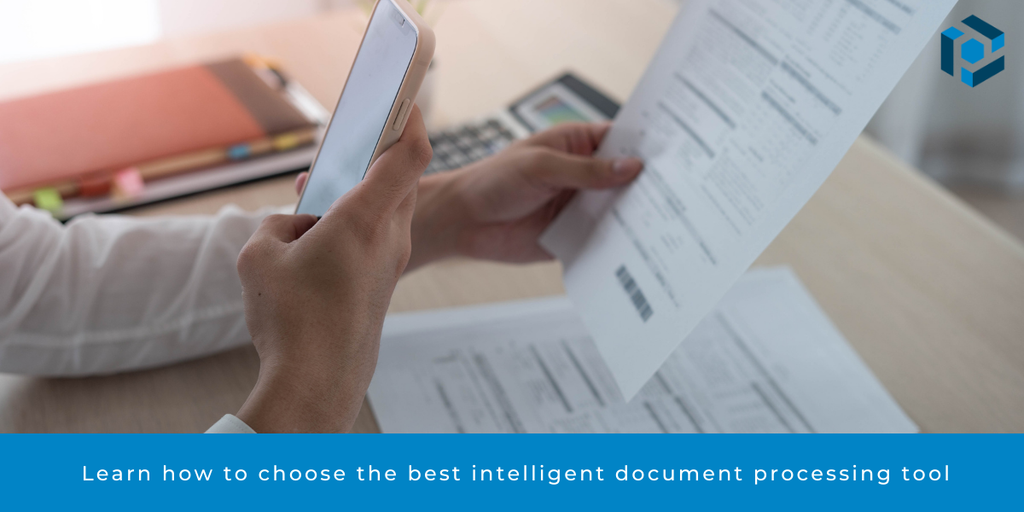Intelligent Document Processing (IDP) automates data extraction, validation, and routing from documents like invoices, emails, and PDFs.
Key Takeaways:
- Intelligent Document Processing (IDP) automates data extraction, validation, and delivery from documents to reduce manual workload.
- AI-powered tools automate unstructured data handling and improve accuracy across business workflows.
- Parseur helps teams automate document processing end-to-end, saving time and eliminating repetitive tasks.
In simple terms, the main purpose of IDP (also known as intelligent document automation) is to minimize human intervention with technology. Also known as document assembly, it helps to extract data from different sources and layouts.
Intelligent document processing (IDP) combines artificial intelligence (AI), predictive analysis, and natural language processing to automate how organizations handle data. It goes beyond simple data extraction to fully digitize and simplify document-based workflows.
As per a report from ThinkAutomation, the digital automation market is currently worth $6.76 billion and will increase up to $12.61 billion by 2023.
We have put together a full guide to explain what intelligent document processing is about and how companies can leverage it to scale up their business.
What is IDP?
Wikipedia defines document processing automation as the design of systems and workflows that assist in the creation of electronic documents.
"Automatically collecting required data from different types of documents, approving its validity, and make use of the extracted data adding relevant features and increasing its value"- definition by AI Multiple, May 2020
As per the latest study by Fact.MR, the global market for business workflow automation is likely to experience a strong growth. Technology-based solution is estimated to exceed US$ 2,100 million revenue by the end of 2026.
By 2026 end, the global market for business workflow automation is projected to bring in US$ 5,247.2 million revenue.
- Fact.MR
North America is expected to dominate the global business workflow automation market throughout the forecast period. Document processing automation is gaining attention globally as it provides disruptive solutions for data extraction.
How does intelligent document processing work?
Data extraction is converting unstructured data into structured data and plays a significant role in document processing automation. A report published on Forbes in 2019 stated that 95% of businesses have to manage unstructured data regularly.
The extraction of data depends 3 types of documents:
- Unstructured data is data which does not have a pre-defined structure and cannot be read by computers. Examples of unstructured data include books, journals, medical records, or text files.
- Semi-structured data is a type of unstructured data that cannot be organized. Digital photographs, date stamps, images and invoices are considered semi-structured.
- Structured data is information that has been transformed into a well-defined data model.
Read more about structured data vs unstructured data
The 7 steps of document processing automation

Handling document processing manually is prone to errors and time-consuming. By switching to automated tools, companies can generate more documents automatically within seconds.
- Data ingestion
- Data capture
- Data classification
- Data extraction
- Data validation
- Data transformation
- Data export
We have highlighted the steps of document processing automation below which requires zero human intervention.
Step 1: Data ingestion
Document ingestion is the first stage of intelligent document processing. It’s how documents enter the system, whether through email, file upload, shared folders, or an API connection.
- Common sources include PDFs, images, spreadsheets, and scanned documents.
- Example: invoices or receipts arrive automatically by email or batch upload to the IDP platform.
Step 2: Data capture
Before extracting data, scanned documents and images must be cleaned and converted into machine-readable text. This step ensures OCR accuracy and consistent formatting.
- Techniques include image enhancement, deskewing, and noise reduction.
- Example: OCR extracts readable text from a scanned invoice or handwritten receipt.
Step 3: Data classification
Data extraction identifies and captures key information from each document. Using AI and pattern recognition, the system recognizes structured fields and extracts them automatically for different use cases across industries, from invoices and purchase orders to contracts and forms.
- Fields may include invoice numbers, supplier names, totals, and dates.
- Example: automatically capture “invoice number” and “amount due” for use in accounting, reporting, or analytics.
Step 4: Data extraction
Once data is extracted, validation ensures accuracy and compliance with predefined rules. The system checks for missing fields, formatting errors, and duplicates.
- Logical checks confirm the data meets business and accounting standards.
- Example: flag invoices missing a supplier VAT number or incorrect totals.
Read more on what is data extraction
Step 5: Data transformation
This step refines extracted data for consistency and usability. Data is standardized, mapped to internal formats, and enriched with relevant external details.
- Formats like dates, currencies, or vendor names are normalized for accuracy.
- Example: convert dates to YYYY-MM-DD and align supplier names with master records.
Step 6: Data validation
When the system encounters uncertain data, it routes those cases for human verification. This ensures data quality and continuous productive analysis improvements.
- Users can review and correct flagged fields directly in the dashboard.
- Example: an unreadable attachment or a new document layout is sent to a reviewer.
Step 7: Data export
The final step is exporting clean, verified data to other business systems. Through integrations and APIs, extracted data flows automatically into CRMs, ERPs, or spreadsheets.
- Data delivery is often real-time, ensuring immediate availability across workflows.
- Example: export invoice fields directly to your accounting software or Google Sheets.
Benefits of using intelligent document processing in your business
IDP can be applied to any industry and different use cases such as finance, real estate and the food industry among others. The benefits in implementing this type of workflow automation in your company are as follows:
Cost savings in time and resources
As per Mckinsey's report, when it comes to business processes, 60% of occupations could save 30% of their time with automation. There is a huge amount of time and resources that could be saved by automating repetitive tasks.
However, the true value of automation goes beyond efficiency; it depends on accuracy. Many organizations automate workflows only to realize that inconsistent or incomplete data slows everything down. When the foundation of automation is poor-quality input, teams spend more time correcting errors than gaining insights. High-quality, standardized data is what transforms automation from a time-saving tool into a strategic enabler.
At the same time, automation also empowers employees. By eliminating repetitive, manual data entry, teams can focus on higher-impact work like analysis, decision-making, and innovation. This change doesn’t just improve productivity; it also boosts job satisfaction and engagement. When employees spend less time fixing data errors or processing routine documents, they can contribute to more strategic initiatives that drive business growth.
90% of employees are being burdened with boring and repetitive tasks which could be easily automated - Key demand statistics, ThinkAutomation.
A benchmark made at Parseur in June 2024, concluded that on average a customer of Parseur document processing tool saves about 150 hours of manual data entry and about $6,413 every month. - Parseur statistics, June 2024
Zero human errors
Manually going through hundreds of documents on a daily basis is prone to human errors. Through document processing automation, you can reduce those errors to almost zero.
Backup of data
It goes without saying that using automated tools will backup your data automatically. Document processing tools are usually cloud-based applications where your data is stored safely and you can access them anytime and anywhere.
Pre-trained models and ready-made templates
There are automated solutions that provide ready-made templates for different industries. For example, Parseur supports a lot of real estate platforms where your documents are extracted and processed automatically (contact details, property information, lead source).
Process-efficiency
Businesses can focus on other core aspects such as customer experience and thus increasing productivity & sales. Implementing automation in the office generates 30-200% ROI in the first year, mainly in labour savings Since staff no longer have to work on time-consuming tasks, they can better utilize their creative time for the company.
Features of an intelligent document processing tool
When choosing an automated document processing tool for your business, it is important to understand what type of features your company will require. We have highlighted the main common features below:
User-friendly and seamless workflows
You might want to take up an automated tool which is easy to use, especially if you're not tech savvy. A no-code tool with zero coding knowledge where you can have seamless workflows between different processes would do great!
Integration with other applications
Integrating the document processing tool with any application of your choice will contribute to time-saving as well. For instance, if you are using the tool for lead generation, it is essential that you can connect to other applications such as Mailchimp or Intercom so that data is sent automatically across.
Types of IDP solutions
With the advent of big data and technology, the extraction of data can be done in many different ways, depending on how many documents need to be processed or in which structure.
AI builder by Power Automate
The AI builder is the new Microsoft automated tool that allows you to add artificial intelligence in your applications and integrations. With a simple point and click experience, you can build different AI models which can be tailor-made for your organization.
OCR
Optical character recognition (OCR) converts images (scanned PDFs, photos, screenshots) into plain text so machines can read the words on a page. OCR is the essential first step for extracting data from images, but by itself it only produces raw text; it doesn’t understand document structure or which pieces of text are meaningful fields.
Neural networks (a type of machine learning model) are typically trained during a long, compute-intensive phase on a very large corpus of documents (public or licensed datasets, not customers’ private files). That pre-training teaches the model general patterns: what an invoice looks like, how dates and totals are usually formatted, common label/value layouts, and so on.
Because of that pre-training, these models can be applied to new documents and reliably identify and classify fields across many layouts and languages — giving more accurate, resilient extraction than OCR alone or fixed template rules. Importantly, Parseur does not train these base models on customers’ documents; the models are applied to customer files without using them to retrain the core system.
Natural Language Processing (NLP) takes it a step further by helping automation systems interpret meaning and context, not just text. With NLP, tools can differentiate between similar terms (like “invoice number” and “reference ID”), understand sentence structures, and extract information even from unstructured documents such as emails or contracts.
Finally, Robotic Process Automation (RPA) bridges the gap between data extraction and business action. Once OCR, ML, and NLP capture and interpret the right data, RPA uses that information to trigger workflows automatically, such as updating an ERP system, sending notifications, or reconciling payments. Together, these technologies create a seamless automation pipeline: OCR reads, ML learns, NLP understands, and RPA acts, all ensuring speed, consistency, and reliability in document-driven processes.
Use Cases of Intelligent Document Processing
Intelligent Document Processing (IDP) can automate workflows across departments and industries, transforming unstructured data into structured, actionable insights. By combining OCR, machine learning, and natural language processing, IDP bridges the gap between raw documents and business-ready data. This not only accelerates operations but also enhances accuracy, compliance, and scalability, key priorities in ISO 8000-aligned automation.
Here are a few practical examples:
Accounts Payable
IDP simplifies invoice processing by automatically extracting key fields, including vendor names, totals, and tax codes, from invoices in over 160 languages. According to Ascend, the average cost of processing a paper invoice is approximately $15, compared to just $2.36 when it is automated. Parsed data flows directly into ERP or accounting tools like QuickBooks or Zoho Invoice, cutting manual entry, minimizing errors, and improving cash-flow visibility.
Order Processing
IDP simplifies order processing workflows by automatically extracting line items, order numbers, supplier details, quantities, and totals from purchase orders. According to Reuters, 57% of procurement teams still rely on manual data entry, and the platform achieves up to 99.9% accuracy when parsing POs. Once extracted, this structured data is pushed directly into order management or ERP systems, significantly reducing manual tasks and enabling faster fulfillment and compliance.
HR/Onboarding
Parseur extracts key fields from resumes like contact info, education, and work experience while supporting anonymized workflows by removing PII. Once parsed, this structured data is routed into HR tools or applicant tracking systems (ATS) like BambooHR or Monday via API or integrations. This enables HR teams to focus on talent evaluation and engagement instead of repetitive data entry.
Parseur: Best intelligent document processing software in 2026
Parseur is an AI document processing tool that extracts data from emails and and PDFs. With an AI document parsing tool like Parseur, you can save countless hours of manual work and have an automated workflow process in place.
Parseur's AI software is the best and brightest AI parsing engine on the market to process documents into structured data. And, it adapts to any layout.
Parseur can also be integrated with thousands of applications such as Zapier, Power Automate and Integromat.
By embedding document processing automation within your organization, you will enable end-to-end automatic business processes. The introduction of document processing automation has numerous advantages that help to streamline business operations and achieve quicker results.
Frequently Asked Questions
As more businesses turn to automation to streamline operations, questions often arise about what Intelligent Document Processing (IDP) can do and how it fits into existing workflows. Below, we’ve answered some of the most common questions to help you better understand how IDP works, its benefits, and how tools like Parseur can make automation effortless.
-
What is the main purpose of Intelligent Document Processing (IDP)?
-
The primary goal of IDP is to automate the extraction, validation, and organization of data from various documents. It helps businesses save time, reduce human errors, and ensure consistent, accurate data processing across all workflows.
-
How is IDP different from traditional OCR?
-
While OCR (Optical Character Recognition) converts images and scanned documents into readable text, IDP goes several steps further. It uses AI, machine learning, and natural language processing to understand document context, extract structured data, and route it automatically to other business systems.
-
What types of documents can IDP process?
-
IDP can process nearly any type of document, from invoices, receipts, and purchase orders to contracts, forms, and emails. Whether structured, semi-structured, or unstructured, intelligent systems can learn to handle diverse document formats.
-
How can Parseur help automate document processing?
-
Parseur automates the entire document workflow from email parsing to data extraction and export. With ready-made templates and no-code setup, businesses can extract key information instantly and send it to apps like Google Sheets, Power Automate, or Zapier without manual intervention.
-
What are the benefits of implementing IDP in a company?
-
The key benefits include reduced manual workload, faster processing times, improved data accuracy, and significant cost savings. Many companies also see higher employee satisfaction, as teams spend less time on repetitive tasks and more on value-driven activities.
-
Is IDP suitable for small businesses?
-
Yes! Intelligent Document Processing can grow with demand and be adaptable. Small businesses can start small, automating just a few repetitive document workflows and expanding as they grow. Cloud-based tools like Parseur make this transition simple and affordable.
-
How secure is document processing automation?
-
Most modern IDP tools, including Parseur, are cloud-based and follow strict data protection standards. Data is encrypted, stored securely, and accessible only to authorized users, ensuring compliance with regulations such as GDPR.
Last updated on






